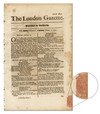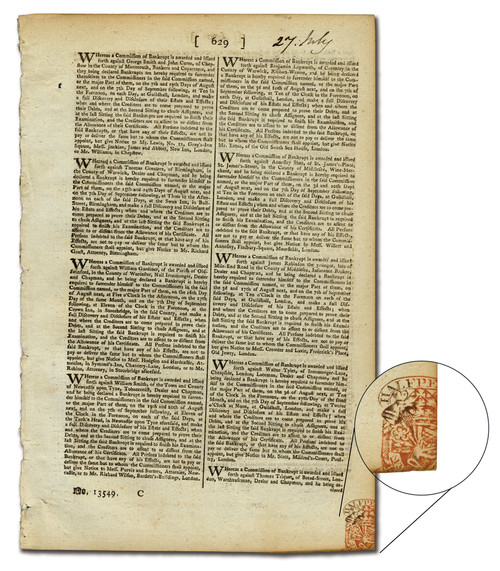
# MA1871 - 1700's Great Britain Newspaper Tax Stamp, Typical Strike, 40-60% Visible
Own Great Britain Newspaper Tax Stamp – Now Over 300 Years Old!
Mystic recently acquired a small number of British newspapers from the 1700s featuring examples of the stamp tax. Examples will vary, but you'll receive a "typical strike" (most common, stamp may be slightly smudged or under-inked) on a page of a newspaper or sometimes an entire newspaper. It's a neat piece of history that we can link to the taxes that eventually led America to rebel and declare independence from Great Britain. Not many people can say they own a 300-year-old piece of history. Become one of them and order yours today.
These Stamps Inspired Famous "America" Newspaper Tax Stamp
After having success with their own Newspaper Tax stamps, Britain later implemented them in the American colonies in November 1765 with the passage of the infamous "Stamp Act." This applied a 1¢ tax per sheet on newspapers and required all newspapers to be printed on stamps paper from the government. The design consisted of a mantle; St. Edward's Crown encircled by the Order of the Garter; anda scepter and sword. At the top they inscribed "AMERICA"; at the bottom "ONE PENNY" and the number of the printing die (200 copper dies and eight plates were prepared). Dark red proof impressions of the plates were made on thick laid paper before the stamped paper was produced.

As you well know, colonists were outraged by the Stamp Act and staged a number of protests against the taxes. No used "America" printed stamps are known to exist. Today, just 32 copies of the original dark-red proof impressions made in 1765 survive. Twenty-six of these are held in the British Library Philatelic Collections, with five others in private hands, and one in the Smithsonian National Postal Museum.
History of Great Britain Newspaper Tax
Great Britain started taxing newspapers and almanacs in 1711 with the dual goal of raising money to fund wars (such as the War of Spanish Succession) and limiting newspaper circulation. (Newspapers gave the people a way to criticize the government and easily circulate their ideas.) The tax was 50% on the newspaper.
Tax stamps were first used 129 years before the first postage stamp, the Penny Black. They were first issued during the last years of Queen Anne's rule. She died in 1714 and was succeeded by King George I, grandfather of the infamous George III who America rebelled against. Parliament passed the Stamp Act in 1712.
How Were These Stamps Produced?
After the plates were made, three people were needed to print the stamps: a printer, someone to lay the paper, and someone to take off the paper. The stamps were printed on blank paper on circular plates of 25 before the newspaper was printed. The person who laied the paper would set out 25 different sheets of peper, overlapping so a corner of the page showed. These 25 sheets were then laid on the printing press, moistened with water to help ink coverage, and then inked. The printer operated the hand press which pulled the paper through the press. After printing, someone removed the printed pages and laid them out to dry. After drying, the paper was sold to newspaper and almanac publishers for use.
Most newspaper examples that still exist today only show a portion of the stamp. This is due to a combination of factors. First, the person who laid the paper all those years ago likely was working quickly without always paying attention to the postioning of the stamp. Secondly, many printers likely tried to get the job done as quickly as possible, leading to unclear, smudged, or under-inked stamps.
Design Explanation
The intricate design of these stamps is beautiful and full of symbolism. It shows a Tudor rose on the left and Scottish thistle "both browing from the same leafy stem torn from the parent branch leaving a basel heel" with St. Edward's crown and Queen Anne's motto Semper Eadem (Always The Same).
Own Great Britain Newspaper Tax Stamp – Now Over 300 Years Old!
Mystic recently acquired a small number of British newspapers from the 1700s featuring examples of the stamp tax. Examples will vary, but you'll receive a "typical strike" (most common, stamp may be slightly smudged or under-inked) on a page of a newspaper or sometimes an entire newspaper. It's a neat piece of history that we can link to the taxes that eventually led America to rebel and declare independence from Great Britain. Not many people can say they own a 300-year-old piece of history. Become one of them and order yours today.
These Stamps Inspired Famous "America" Newspaper Tax Stamp
After having success with their own Newspaper Tax stamps, Britain later implemented them in the American colonies in November 1765 with the passage of the infamous "Stamp Act." This applied a 1¢ tax per sheet on newspapers and required all newspapers to be printed on stamps paper from the government. The design consisted of a mantle; St. Edward's Crown encircled by the Order of the Garter; anda scepter and sword. At the top they inscribed "AMERICA"; at the bottom "ONE PENNY" and the number of the printing die (200 copper dies and eight plates were prepared). Dark red proof impressions of the plates were made on thick laid paper before the stamped paper was produced.

As you well know, colonists were outraged by the Stamp Act and staged a number of protests against the taxes. No used "America" printed stamps are known to exist. Today, just 32 copies of the original dark-red proof impressions made in 1765 survive. Twenty-six of these are held in the British Library Philatelic Collections, with five others in private hands, and one in the Smithsonian National Postal Museum.
History of Great Britain Newspaper Tax
Great Britain started taxing newspapers and almanacs in 1711 with the dual goal of raising money to fund wars (such as the War of Spanish Succession) and limiting newspaper circulation. (Newspapers gave the people a way to criticize the government and easily circulate their ideas.) The tax was 50% on the newspaper.
Tax stamps were first used 129 years before the first postage stamp, the Penny Black. They were first issued during the last years of Queen Anne's rule. She died in 1714 and was succeeded by King George I, grandfather of the infamous George III who America rebelled against. Parliament passed the Stamp Act in 1712.
How Were These Stamps Produced?
After the plates were made, three people were needed to print the stamps: a printer, someone to lay the paper, and someone to take off the paper. The stamps were printed on blank paper on circular plates of 25 before the newspaper was printed. The person who laied the paper would set out 25 different sheets of peper, overlapping so a corner of the page showed. These 25 sheets were then laid on the printing press, moistened with water to help ink coverage, and then inked. The printer operated the hand press which pulled the paper through the press. After printing, someone removed the printed pages and laid them out to dry. After drying, the paper was sold to newspaper and almanac publishers for use.
Most newspaper examples that still exist today only show a portion of the stamp. This is due to a combination of factors. First, the person who laid the paper all those years ago likely was working quickly without always paying attention to the postioning of the stamp. Secondly, many printers likely tried to get the job done as quickly as possible, leading to unclear, smudged, or under-inked stamps.
Design Explanation
The intricate design of these stamps is beautiful and full of symbolism. It shows a Tudor rose on the left and Scottish thistle "both browing from the same leafy stem torn from the parent branch leaving a basel heel" with St. Edward's crown and Queen Anne's motto Semper Eadem (Always The Same).






